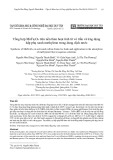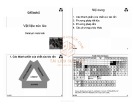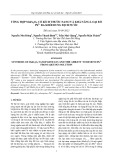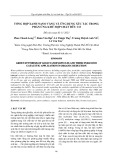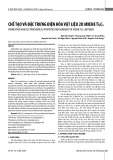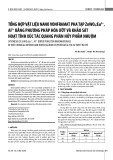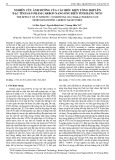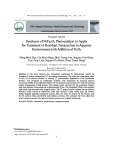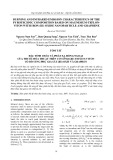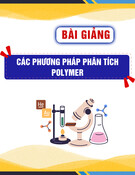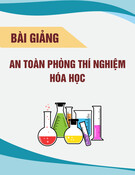
51
Tạp chí phân tích Hóa, Lý và Sinh học - Tập 30, số 02/2024
BURNING AND INFRARED EMISSION CHARACTERISTICS OF THE
PYROTECHNIC COMPOSITION BASED ON MAGNESIUM-TEFLON-
VITON WITH IRON (III) OXIDE NANOPARTICLE AND GRAPHENE
Received 29-05-2024
Nguyen Nam Son1*, Dam Quang Sang1, Nguyen Van Tinh1, Tran Tien Bao2
1 Le Quy Don Technical University, Bac Tu Liem District, Ha Noi, Viet Nam
2 Academy of Military Science and Technology, Cau Giay District, Ha Noi, Viet Nam
*Email: nguyennamson21@lqdtu.edu.vn
TÓM TẮT
ĐẶC TÍNH CHÁY VÀ PHÁT XẠ HỒNG NGOẠI
CỦA THUỐC HỎA THUẬT TRÊN CƠ SỞ MAGIE-TEFLON-VITON
CÓ BỔ SUNG PHỤ GIA SẮT (III) OXIT VÀ GRAPHEN
Bài báo trình bày các nghiên cứu về ảnh hưởng của nano-Fe2O3 và graphen đến đặc tính cháy và phát xạ
của chế phẩm pháo hoa MTV. Phương pháp phân tích ảnh SEM và EDX được sử dụng để đánh giá hình thái
học và sự góp mặt của phụ gia trong vật liệu. Đo quang phổ và sử dụng máy quay phim tốc độ cao để xem
xét sự đóng góp của các phụ gia vào tốc độ cháy và phát xạ của vật liệu. Kết quả nghiên cứu đã chỉ ra, so
với các mẫu không bổ sung phụ gia, các mẫu chứa Fe2O3 nano và graphen có tốc độ cháy tăng lên 1,9 lần,
hàm phân bố độ chói theo bước sóng (spectral radiance) tăng lên 1,5 lần. Tuy nhiên, nhiệt độ cháy có xu
hướng không thay đổi nhiều khi được bổ sung 2 loại phụ gia Fe2O3 nano và graphen. Tỷ lệ hàm lượng
Fe2O3/graphen được bổ sung để hàm phân bố độ chói theo bước sóng của hỗn hợp MTV ở các bước sóng
khác nhau đạt giá trị lớn nhất là 4/8.
Từ khóa: Hàm phân bố độ chói theo bước sóng, xúc tác cháy, MTV, Fe2O3 nano, graphen.
1. INTRODUCTION
Infrared decoy flares are one of the effective
measures used to protect aircraft against current
infrared-guided missiles. The requirements of
pyrotechnic composition used in decoy flares are
as follows: the radiant intensity must exceed that
of aircraft within the missile’s search wavelength
band; the time to reach peak intensity should
usually be less than one second; the burning time
must be long enough, approximately four seconds,
to prevent the missile reaching the target after the
pyrotechnic mixture is extinguished [1, 2]. The
ability to emit in a specified wavelength band of
the pyrotechnic composition is mainly expressed
(measured) in the following parameters: spectral
intensity Iλ, spectral radiance Lλ, and spectral
efficiency Eλ. These parameters are determined as
follows [2-7].
-1 -1
(W.sr .μm )I
(1)
-1 -2 -1
(W.sr .m .μm )
.cos .
L
(2)
-1 -1 -1
1
. . . . (J.g .sr .μm )
4.
c w a
E H F
(3)
Iλ = Eλ.
ṁ
(W.sr-1.μm-1) (4)
where, Фλ (W) is the spectral flux of the emission
source; ω (steradian) and Ω (m2) are the solid angle
and projected area of the emitting surface,
respectively; θ (radian) is the angle between the
direction perpendicular to the emitting surface and
the viewing direction; ΔcH (J.g-1) is the enthalpy of
combustion of the payload; Fλ is the reaction
enthalpy that contributes to the radiant energy in
the band of interest; δw is the windstream





